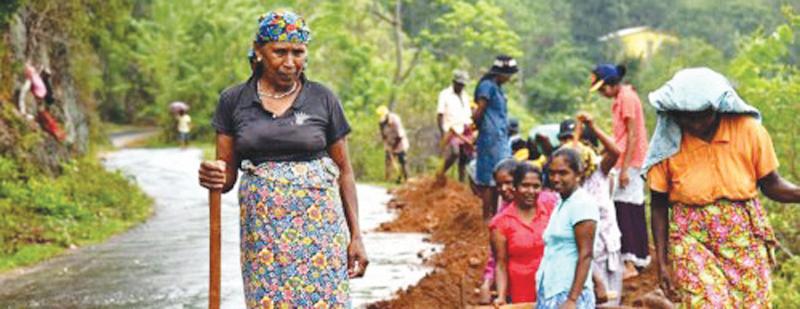
The 2019 Women’s Wellbeing Survey (WWS) in Sri Lanka was conducted by the Department of Census and Statistics (DCS) with technical assistance from the United Nations Population Fund (UNFPA) and its regional kNOwVAWdata Initiative.
It is the first national survey carried out in Sri Lanka according to an internationally recognised standardised methodology on violence against women and girls. The Women’s Wellbeing Survey (WWS) conducted islandwide gathered information from over 2,200 women aged 15 and above. The study revealed that one in five (20.4%) ever-partnered women have experienced physical and/or sexual violence by an intimate partner in their lifetime.
According to the study, 49.3% of women who experienced sexual violence by their partner avoided seeking formal help due to reasons, such as shame, embarrassment, fear of being blamed or not being believed, and/or thinking the violence was normal or not serious enough to seek help. Quarantine rules imposed due to the Covid-19 pandemic have complicated the issue. Despite the current situation, consultative workshops are scheduled to be held with key Government stakeholders and other development partners over the next few months to better inform decision-making to ensure no one is left behind.
Employment, economic security, equal access to resources, political participation, decision making, health and personal safety are a few factors on which women’s well-being depend. Violence against women in Sri Lanka has avoided them from living life to the fullest potentials.
Domestic violence
 Domestic violence has become normalised and as a result, many women are unaware that they are being subjected to violence. The Prevention of Domestic Violence Act (No. 34 of 2005), defines “domestic violence” as: “an act which constitutes an offence specified in Schedule; any emotional abuse, committed or caused by a relevant person within the environment of the home or outside and arising out of the personal relationship between the aggrieved person and the relevant person”.
Domestic violence has become normalised and as a result, many women are unaware that they are being subjected to violence. The Prevention of Domestic Violence Act (No. 34 of 2005), defines “domestic violence” as: “an act which constitutes an offence specified in Schedule; any emotional abuse, committed or caused by a relevant person within the environment of the home or outside and arising out of the personal relationship between the aggrieved person and the relevant person”.
This could take the forms of sexual and gender-based violence or intimate partner violence.
Women should be aware of how ‘sexual and gender-based violence’ and ‘intimate partner violence’ is caused as it is the key way to identify the type of violence they encounter. Sexual and gender-based violence (SGBV) refers to any act that is perpetrated against a person’s will and is based on gender norms and unequal power relationships and highlights the sexual violence component of GBV (Gender-Based Violence), which is the most demeaning and degrading experience to the survivor. Somehow, many acts of violence against women are committed by husbands or partners.
This has been defined as Intimate Partner Violence (IPV), which is “behaviour by an intimate partner or ex-partner that causes physical, sexual or psychological harm, including physical aggression, sexual coercion, psychological abuse and controlling behaviorus”.
According to the United Nations Organisation (UNO), violence against women is not limited to: physical, sexual, and psychological violence occurring in the family, including dowry-related violence, marital rape, female genital mutilation, intimidation at work, in educational institutions and elsewhere, trafficking in women and forced prostitution.
The UNO has identified that if a woman is slapped or somebody had thrown something at her that could hurt her, pushed or shoved or had her hair pulled, hit with a fist or with something else that could hurt her, as kicked, dragged or beaten up, was choked or burnt on purpose, threatened to use or used a gun, knife or another weapon against her, such actions are also considered to be violence against women.
Sexual violence
The survey uncovered how a woman is subjected to sexual violence by an intimate partner. Being forced to have sexual intercourse when she did not want to, for example by being threatened or held down, had sexual intercourse when she did not want to because she was afraid of what her partner might do if she refused, being forced to do anything else sexual that she did not want or that she found degrading were the actions most of the abusive partners commit. The survey identified the actions of emotional violence: insulting or made a woman feel bad about herself, belittling or humiliating her in front of other people, doing things to scare or intimidate her on purpose (e.g. by the way looked at her, by Women’s Wellbeing Survey - 2019), yelling or smashing things, threatening verbally to hurt her or someone she cared about.
According to the survey, the scope of emotional violence took numerous forms; trying to keep her from seeing friends, trying to restrict contact with her family of birth, insisting on knowing where she is at all times, preventing from using social media, getting angry if she speaks with another man, being often suspicious that she is unfaithful, expecting her to ask permission before seeking healthcare for herself. Economic violence was also detected as prohibiting from being employed, taking her earnings against her will and refusing to give money for household expenses.
